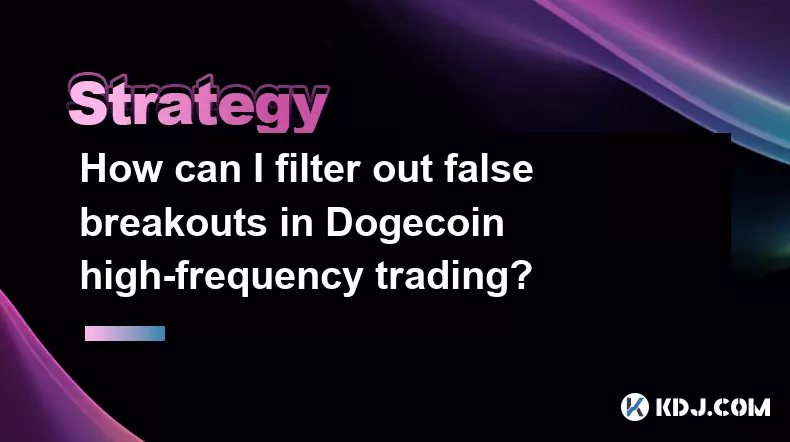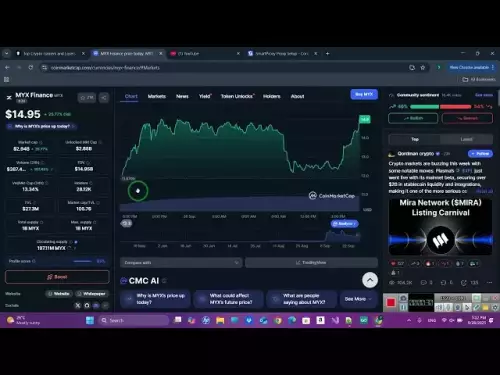-
 bitcoin
bitcoin $109547.008142 USD
0.04% -
 ethereum
ethereum $4011.838726 USD
-0.05% -
 tether
tether $1.000402 USD
-0.01% -
 xrp
xrp $2.798606 USD
0.88% -
 bnb
bnb $970.877944 USD
1.39% -
 solana
solana $202.237275 USD
-0.95% -
 usd-coin
usd-coin $0.999673 USD
0.00% -
 dogecoin
dogecoin $0.229294 USD
-1.15% -
 tron
tron $0.336370 USD
-0.45% -
 cardano
cardano $0.777260 USD
-1.66% -
 hyperliquid
hyperliquid $45.503019 USD
1.73% -
 ethena-usde
ethena-usde $1.000362 USD
0.01% -
 chainlink
chainlink $20.785303 USD
-1.10% -
 avalanche
avalanche $28.755822 USD
-0.11% -
 stellar
stellar $0.358303 USD
-0.48%
How can I filter out false breakouts in Dogecoin high-frequency trading?
False breakouts in Dogecoin trading trap traders when price briefly breaches key levels but reverses, often due to low volume, thin order books, or algorithmic noise.
Sep 22, 2025 at 01:00 am

Understanding False Breakouts in Dogecoin Trading
1. A false breakout occurs when Dogecoin's price appears to move beyond a defined support or resistance level but quickly reverses, trapping traders who acted on the initial signal. These misleading movements are common in high-frequency trading due to rapid market fluctuations and algorithmic noise.
2. In the volatile environment of meme coins like Dogecoin, false breakouts happen more frequently because sentiment-driven spikes can mimic genuine momentum. Traders relying solely on price action without context may fall victim to these deceptive patterns.
3. High-frequency systems amplify the risk because they execute trades within milliseconds. If the system interprets a short-term spike as a confirmed breakout, it may open positions that become immediately unprofitable once the price retracts.
4. Volume analysis plays a critical role in identifying authentic breakouts. A true breakout usually coincides with a significant increase in trading volume, indicating strong market participation. A surge in price without corresponding volume often signals weakness and potential reversal.
5. Order book depth can reveal whether a breakout has real backing. Thin order books at key levels suggest low liquidity, making it easier for large orders or bots to manipulate prices temporarily and trigger false signals.
Technical Filters to Confirm Breakouts
1. Use candlestick closing confirmation instead of reacting to intrabar movements. Wait for the current time frame’s candle to close beyond the resistance or support level before considering the breakout valid. This reduces impulsive entries based on transient wicks.
2. Apply multiple time frame validation. Check higher time frames (e.g., 15-minute or hourly charts) to see if the breakout aligns with broader trends. A breakout on a 1-minute chart that contradicts the 15-minute trend is more likely to fail.
3. Incorporate volatility filters such as Average True Range (ATR). If the breakout occurs during a period of abnormally high volatility without fundamental cause, it may lack sustainability. Filtering trades during extreme ATR readings helps avoid noise.
4. Utilize Bollinger Bands to assess price extremities. When Dogecoin’s price touches or exceeds the upper or lower band without a clear catalyst, especially on compressed bands, the move may be an overextension rather than a sustainable breakout.
5. Combine breakout signals with momentum oscillators like RSI or MACD. Overbought conditions (RSI > 70) during an upward breakout suggest exhaustion, while bearish divergence on MACD warns of weakening momentum despite price rising.
Algorithmic Safeguards in HFT Systems
1. Implement latency-based filters that require sustained price movement over several ticks. Instead of triggering on a single tick beyond a level, require the price to remain above or below that level for a predefined number of seconds or transactions.
2. Integrate machine learning models trained on historical Dogecoin data to classify breakout quality. Features such as volume delta, bid-ask imbalance, and microstructure patterns can help distinguish real from fake moves.
3. Use dynamic stop-loss and take-profit logic tied to recent volatility. Fixed thresholds may lead to premature exits during normal retracements, while adaptive parameters maintain position integrity through minor reversals.
Real-time monitoring of exchange-specific anomalies is essential, as some platforms experience delayed data feeds or irregular order matching that generate phantom breakouts not present across consolidated markets.4. Employ iceberg detection algorithms to identify hidden liquidity absorption. Large players often split orders to mask their intentions. Detecting gradual depletion of order book layers beneath surface-level bids or asks can confirm institutional involvement behind a breakout.
Frequently Asked Questions
What is the role of slippage in false breakout detection?Slippage indicates the difference between expected and executed trade prices. High slippage during a breakout suggests poor liquidity and unstable price levels, which are hallmarks of false moves. Monitoring slippage helps assess execution reliability and market depth.
Can social sentiment data help filter Dogecoin breakouts?Yes. Sudden spikes in social media mentions or chatter on platforms like Reddit or Twitter often precede pump-and-dump schemes. Correlating sentiment surges with price action allows traders to flag potentially manipulated breakouts lacking organic demand.
How does exchange selection impact breakout accuracy?Different exchanges exhibit varying levels of liquidity and manipulation risk. Breakouts on low-volume exchanges may not reflect true market consensus. Prioritizing data from major exchanges like Binance or Kraken improves signal fidelity.
Disclaimer:info@kdj.com
The information provided is not trading advice. kdj.com does not assume any responsibility for any investments made based on the information provided in this article. Cryptocurrencies are highly volatile and it is highly recommended that you invest with caution after thorough research!
If you believe that the content used on this website infringes your copyright, please contact us immediately (info@kdj.com) and we will delete it promptly.
- Blockchain, Eggman, Presale: Why $GGs is the Talk of the Town in 2025
- 2025-09-29 00:25:12
- Crypto Coins 2025: Which Ones Will Explode?
- 2025-09-29 00:25:12
- Crypto Presales in 2026: Chasing ROI Like a New Yorker Chases a Cab
- 2025-09-29 00:30:01
- Ruvi AI: The Next Dogecoin? Explosive Entry Heats Up
- 2025-09-29 00:30:01
- Crypto Projects in 2025: BlockDAG Leads the DApp Support Revolution
- 2025-09-29 00:30:01
- YZY Crypto Concert Tickets: Is Kanye West Building an Empire or Just Playing Games?
- 2025-09-29 00:30:17
Related knowledge

Practical parameter settings for a Bitcoin multi-timeframe moving average system
Sep 18,2025 at 10:54pm
Optimizing Timeframe Combinations for Bitcoin Trading1. Selecting appropriate timeframes is crucial when building a multi-timeframe moving average sys...

How can I filter out false breakouts in Dogecoin high-frequency trading?
Sep 22,2025 at 01:00am
Understanding False Breakouts in Dogecoin Trading1. A false breakout occurs when Dogecoin's price appears to move beyond a defined support or resistan...

Techniques for identifying tops and bottoms in the Bitcoin on-chain NVT model
Sep 20,2025 at 07:54pm
Understanding the NVT Model in Bitcoin Analysis1. The Network Value to Transactions (NVT) ratio is often described as the 'P/E ratio' of the cryptocur...

What does the surge in open interest in Bitcoincoin futures mean?
Sep 20,2025 at 11:18pm
Understanding the Surge in Dogecoin Futures Open Interest1. A surge in open interest within Dogecoin futures indicates a growing number of active cont...

How can I use the Ethereum USDT premium to gauge market sentiment?
Sep 18,2025 at 11:55pm
Understanding the Ethereum USDT Premium1. The Ethereum USDT premium refers to the price difference between USDT (Tether) traded on Ethereum-based plat...

What should I do if Ethereum staking yields decline?
Sep 20,2025 at 06:18am
Understanding the Causes Behind Declining Ethereum Staking Yields1. The Ethereum network transitioned to a proof-of-stake consensus mechanism with the...

Practical parameter settings for a Bitcoin multi-timeframe moving average system
Sep 18,2025 at 10:54pm
Optimizing Timeframe Combinations for Bitcoin Trading1. Selecting appropriate timeframes is crucial when building a multi-timeframe moving average sys...

How can I filter out false breakouts in Dogecoin high-frequency trading?
Sep 22,2025 at 01:00am
Understanding False Breakouts in Dogecoin Trading1. A false breakout occurs when Dogecoin's price appears to move beyond a defined support or resistan...

Techniques for identifying tops and bottoms in the Bitcoin on-chain NVT model
Sep 20,2025 at 07:54pm
Understanding the NVT Model in Bitcoin Analysis1. The Network Value to Transactions (NVT) ratio is often described as the 'P/E ratio' of the cryptocur...

What does the surge in open interest in Bitcoincoin futures mean?
Sep 20,2025 at 11:18pm
Understanding the Surge in Dogecoin Futures Open Interest1. A surge in open interest within Dogecoin futures indicates a growing number of active cont...

How can I use the Ethereum USDT premium to gauge market sentiment?
Sep 18,2025 at 11:55pm
Understanding the Ethereum USDT Premium1. The Ethereum USDT premium refers to the price difference between USDT (Tether) traded on Ethereum-based plat...

What should I do if Ethereum staking yields decline?
Sep 20,2025 at 06:18am
Understanding the Causes Behind Declining Ethereum Staking Yields1. The Ethereum network transitioned to a proof-of-stake consensus mechanism with the...
See all articles









































































